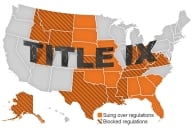You have /5 articles left.
Sign up for a free account or log in.
Most colleges will soon send out financial aid award letters for the upcoming academic year, informing admitted students (as well as those already enrolled) about how much they are expected to pay. In recent years, those letters have prompted a flurry of complaints that they are too confusing and sometimes misleading, and the Education Department, consumer advocates and some members of Congress have pushed for greater standardization.
A study of proposed templates for financial aid letters released today suggests that students and parents want information that’s clear and easy to understand -- but they’re not particularly thrilled with any of the options available so far.
The National Association of Student Financial Aid Administrators tested three “shopping sheets” -- the Education Department’s version, the association’s own suggestion and a hybrid shopping sheet that combined the two -- on several small focus groups of high school and college students, and parents of students, from across sectors of higher education.
About 500 colleges have adopted the Education Department’s “shopping sheet” -- which President Obama touted in his State of the Union address in January -- and will be using it beginning this spring. Colleges that comply with the voluntary Department of Veterans Affairs “principles of excellence” are required to use the shopping sheet for veterans and active-duty military.
The association, which has proposed an award letter template of its own, hasn’t stayed out of fights over standardizing award letters in the past. It has argued that the federal government’s shopping sheet doesn’t give enough flexibility to institutions that work with nontraditional students and is often irrelevant to students who are already enrolled in college. NASFAA has also proposed its own guidelines for award letters, which define terms that all colleges should use but leave more wiggle room for personalization and customization.
The version following the association’s guidelines, though -- which broke down costs on a semester-by-semester basis and differentiated between net tuition and fees after grants and scholarships, net costs after grants and scholarships, and the net cost after grants and loans -- fared less well in focus groups than the other alternatives. Only 40 percent of participants agreed the NASFAA award letter was clear and easy to understand, compared with 56 percent for the Education Department’s shopping sheet and 51 percent for the hybrid version.
Participants in the focus groups were asked whether each letter was clear and easy to understand and whether it would help students make informed decisions. The groups were then asked which letter was the clearest -- a designation that overwhelmingly went to the hybrid of the Education Department’s shopping sheet and NASFAA’s suggestions. The hybrid version removed information about median borrowing and graduation rates and listed the cost of attendance, total gifts and scholarships, and the net costs after aid before offering information on student loans.
Participants weren’t asked which letter makes it easiest to compare institutions -- a key focus of the administration’s shopping sheet push, and the rationale for including information on median student borrowing and graduation rates.
But none of the options were particularly helpful, focus group participants said, when it came to determining how much they would have to pay on their own -- through work-study, student loans or out-of-pocket payments. Of participants given the hybrid award letter, 40 percent could figure out how much they would owe after grants; 42 percent of federal shopping sheet recipients could do so; and 23 percent of those who read NASFAA’s letter said they would know how much they would owe.
In the report, NASFAA called for improved consumer testing of proposed disclosures. “Had any of these three letters been mandated, it likely would have been met with confusion, dissatisfaction and otherwise unnecessary phone calls to institutions,” the group wrote.








